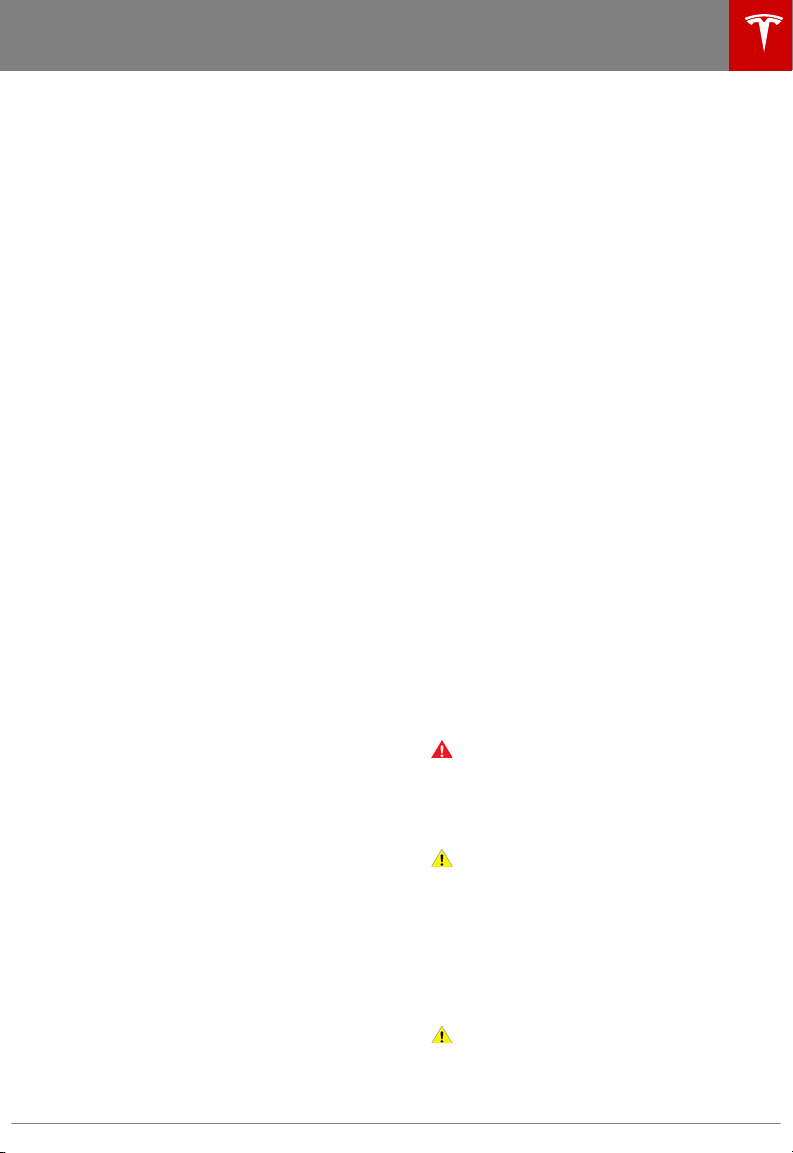Loading ...
Loading ...
Loading ...

About the Battery
Model X has one of the most sophisticated
battery systems in the world. The most
important way to preserve the Battery is to
LEAVE YOUR VEHICLE PLUGGED IN when
you are not using it. This is particularly
important if you are not planning to drive
Model X for several weeks. When plugged in,
Model X wakes up when needed to
automatically maintain a charge level that
maximizes the lifetime of the Battery.
There is no advantage to waiting until the
Battery’s level is low before charging. In fact,
the Battery performs best when charged
regularly.
Note: If the Model X Battery becomes
completely discharged in a situation in which
towing is required, the owner is responsible
for towing expenses. Discharge-related towing
expenses are not covered under the Roadside
Assistance policy.
The peak charging rate of the Battery may
decrease slightly after a large number of DC
Fast Charging sessions, such as those at
Superchargers. To ensure maximum driving
range and Battery safety, the Battery charge
rate is decreased when the Battery is too cold,
when the Battery’s charge is nearly full, and
when the Battery conditions change with
usage and age. These changes in the condition
of the Battery are driven by battery physics
and may increase the total Supercharging
duration by a few minutes over time.
Battery Care
Never allow the Battery to fully discharge.
Even when Model X is not being driven, its
Battery discharges very slowly to power the
onboard electronics. On average, the Battery
discharges at a rate of 1% per day. Situations
can arise in which you must leave Model X
unplugged for an extended period of time (for
example, at an airport when traveling). In
these situations, keep the 1% in mind to ensure
that you leave the Battery with a
sucient
charge level. For example, over a two week
period (14 days), the Battery discharges by
approximately 14%.
Discharging the Battery to 0% may
permanently damage the Battery. To protect
against a complete discharge, Model X enters
a low-power consumption mode when the
charge level drops to 5%. In this mode, the
Battery stops supporting the onboard
electronics to slow the discharge rate to
approximately 4% per month. Once this low-
power consumption mode is active, it is
important to plug in Model X within two
months to avoid Battery damage.
Note: When the low-power consumption
mode is active, the auxiliary 12V battery is no
longer being charged and can completely
discharge within 12 hours. In the unlikely event
that this occurs, you may need to jump start
or replace the 12V battery before you can
charge. In this situation, contact Tesla.
Temperature Limits
For better long-term performance, avoid
exposing Model X to ambient temperatures
above 60° C or below -30° C for more than 24
hours at a time.
Energy Saving Feature
Model X has an energy-saving feature that
reduces the amount of energy being
consumed when Model X is not in use. Touch
Controls > Displays > Energy Saving. For
more information on maximizing range and
saving energy, see Getting Maximum Range
on page 76.
Battery Warnings and Cautions
Warning:
The Battery has no parts that an
owner or a non-Tesla authorized service
technician can service. Under no
circumstances should you open or tamper
with the Battery. Always contact Tesla to
arrange for Battery servicing.
Caution: If the Battery’s charge level falls
to 0%, you must plug it in. If you leave it
unplugged for an extended period, it may
not be possible to charge or use Model X
without jump starting or replacing the 12V
battery. Leaving Model X unplugged for
an extended period can also result in
permanent Battery damage. If you are
unable to charge Model X, contact Tesla
immediately.
Caution: The Battery requires no owner
maintenance. Do not remove the coolant
filler cap and do not add fluid. If the
instrument panel warns you that the fluid
level is low, contact Tesla immediately.
Battery Information
Charging 155
Loading ...
Loading ...
Loading ...